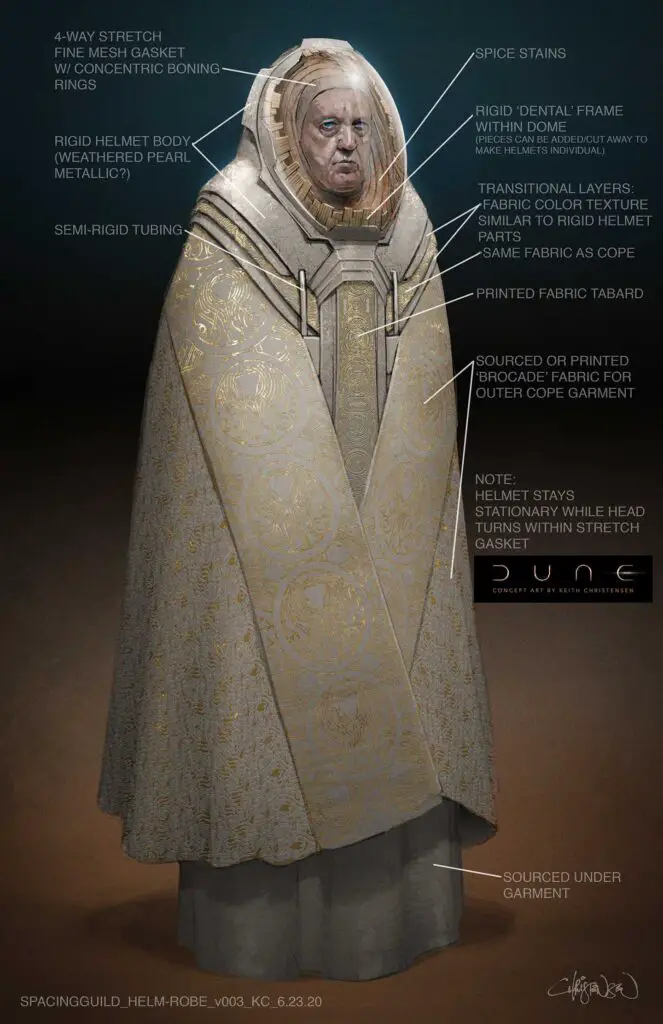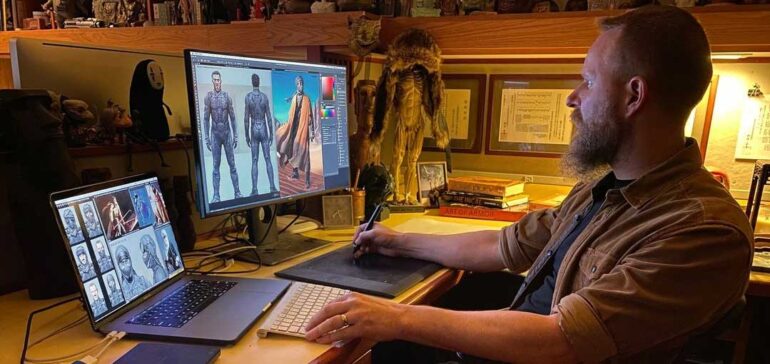
Perhaps I don’t frequent fine art galleries enough, or maybe I haven’t opened my mind to a wider variety of contemporary or historical artwork but, concept art is my favorite kind of static visual illustration. This medium harnesses a creator’s imagination and uses that to capture a director’s or storyteller’s vision. One such artist, Keith Christensen, has managed to channel his talent to create works for movies such as Man of Steel, Dunkirk, Black Panther, Eternals, etc… Among those films, his work on the worlds and characters of Dune was highlighted in a recent interview on Designing Hollywood Podcast.
For any concept artists out there—or just artists in general—Christensen offers great advice during the first 15 minutes of the discussion. Following that, he details his experience in the film industry. We then get into the meat and potatoes of the interview, where the concept artist talks about working on Dune: Part One (starting at 25:10).
Watch the show here and see further commentary, plus concept artwork, below.
Keith Christensen remarks that he is a huge Dune fan, having read the book 5-6 times and loving David Lynch’s adaptation. When he heard that Denis Villeneuve was going to be directing a new movie version of the novel, Christensen felt that combination, of Villeneuve plus Dune, would be amazing. At that point, he simply had to get in on the project.
“Surreal,” Christensen said about landing the project and being able to work on the movie, “Hopefully my stuff lives up to that opportunity, but it just felt… The whole time it just felt very surreal.”
Around the 36:52 mark of the interview, Keith shows a piece of artwork displaying the Atreides battle suit. He explains their approach:
Denis had said that he wanted it to feel like modern tactical armor, like fabric and ballistic nylons and that sort of thing. So, we were starting with the idea—okay we have modern materials and modern details but big medieval shapes. How do you echo the icons of the past and drag it into the future?
This armor went through quite a few iterations before the final version, as seen in the movie, came to be. Both the House Atreides suit—with it’s distinctive hawk-like helmet—and the fear-inspiring combat outfits of their rivals, House Harkonnen, capture the essence of Dune‘s far-future feudal society and its factions’ unique approach to warfare.




Christensen also offered interesting insights regarding developing the Fremen. Although he worked on some of it, much of the work was done by the art team in Hungary.
A lot of that stuff was handled by Jacqui and Bob [art team leads] in Budapest… They did a lot of cool stuff like riffing off of Middle Eastern culture and Bedouin culture and then playing with cool shapes… It’s that cool mix of; I recognize this as being you know, a legitimate believable grounded culture but there’s these things that are off that are telling me that this is not, you know, this is not North Africa. This is a completely other place.
His various contributions to the Fremen warriors were also covered in the conversation, illustrating again how much attention to detail went into this production. Apparently he designed the particular Hare pendant, based on a single mention in the book, that astute fans may catch while watching the movie.


Speaking of the level of detail, in another recent interview, Christensen confirmed that he worked on Dune for almost an year and a significant portion of that effort went into creating their stillsuits.
Yeah, about a year total, with reshoots. The Stillsuit took a while to develop. Director Denis Villeneuve had been working with concept artist Joseph Cross prior to hiring anyone in the costume dept. Kurt and Bart were given Joseph’s design and they asked me to do a take based on it. After much back and forth and many iterations incorporating everyone’s notes and input, a design emerged that Denis approved. There are still some residual elements of Joseph’s design in the final, and consequently, it’s his design that’s seen in the schematic shown in the film.
Keith Christensen speaking to Film Sketchr




One faction that perhaps has not gotten its fair share of attention yet, is the Spacing Guild. The related concept art was elaborated on in the interview. At 46:52, Keith Christensen showed off an early sketch of their appearance—a design that the artist said Villeneuve gravitated toward. After a unique set of inspirations and riffing off those for his idea of the Spacing Guild suits, Christensen talks about his pitch to the director about their spice-filled helmets.
These are Spacing Guild [members]. So, what if that bubble should actually contain the spice, because they have been saturating themselves with it so that they can do their thing. In the movie they ended up kind of completely ghosting it with spice… Making it a lot more mysterious. In hindsight I totally get that. It leaves it up in the air… What’s under there? What has the constant intake of spice done to them? You just don’t know.


Additional information was revealed regarding the Sardaukar, Lady Jessica’s dress and head piece, and Harkonnen concepts during the full recording of the podcast (above). It’s worth checking out to get a deep dive into Keith Christensen’s work, as well as the intricacies of being a professional concept artist.
Christensen recently answered a question regarding his most memorable experience working on this movie. Like so many others involved in this production, he brought up his interactions with the director:
At the risk of sounding sycophantic, and though my interaction was fairly limited, one of the most impactful memories from Dune was showing my work to director Denis Villeneuve. He gave me the impression that whatever we put in front of him, it was truly considered. Even when his initial reaction was negative, he would take the time to sit with it and get back to us with a thoughtful evaluation. I don’t know if I’ll ever get a more treasured compliment than Denis looking at something I designed, and saying in his thick French Canadian accent, “I deeply love it”.
Keith Christensen speaking to Film Sketchr


Sources: Designing Hollywood Podcast YouTube channel (November 9, 2021), Keith Christensen’s ArtStation portfolio (November 11, 2021), Film Sketchr via Maurice Mitchell (October 28, 2021).



